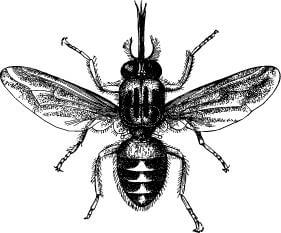The tsetse fly spreads the disease parasite human African trypanosomiasis, better known as sleeping sickness and Ngana disease which affects humans and animals respectively. Across sub-Saharan Africa, 70 million people are at risk of fatal infection.

A 10-year project to uncover the biology of the disease-causing fly has ended
Decoding the genome of the tsetse fly allowed researchers to uncover the genetic characteristics that allow the fly to maintain its unique biology and transmit diseases to both animals and humans.
The tsetse fly spreads the disease parasite human African trypanosomiasis, better known as sleeping sickness and Ngana disease which affects humans and animals respectively. Across sub-Saharan Africa, 70 million people are at risk of fatal infection. Sleeping sickness is on the list of tropical diseases that have not yet been treated by the World Health Organization and which since 2013 has become a target for extinction. Understanding the genome of the tsetse fly and interfering with its ability to transmit the disease is an important part of the campaign.
The disease-carrying fly has developed unusual biological methods to locate and infect its host. Its advanced sensor system allows various species of tsetse fly to track a potential host by both smell and sight. The research revealed some of the parts of key processes and opened a new window for planning prevention strategies and reducing the number of deaths and patients from sleeping sickness and other diseases spread by the tsetse fly.
"Tza-tza flies carry potentially fatal diseases and economic damage to countries whose farmers are the least able to afford to breed cattle species resistant to the disease parasites (trypanosome)." says Matthew Berryman, research partner from the Sanger Institute of the British Wellcome Trats Foundation. "Our research will accelerate the field of research that utilizes the unique biology of the tsetse fly in order to prevent its injury. The more we understand, the more we will be able to identify weaknesses, and use them to control the tsetse fly in areas where sleeping sickness is common."
The team that included 146 scientists from 78 institutions in 18 countries analyzed the genome of the tsetse fly and the 12 genes that control the activity of the proteins. The project, which took a decade to complete, will provide the research community with free access to information in order to accelerate the development and improvement of methods to control the tsetse fly in this neglected area of the world.
The tsetse fly is a close relative of the fruit fly, a favorite laboratory animal of biologists for over 100 years, but its genome is twice the size. Within the genome are genes responsible for the extraordinary biology. The reproductive biology of the tsetse fly is unconventional. Unlike most egg-laying insects, it gives birth to live flies that develop to full size through a specialized gland in the mother.
The researchers discovered a series of proteins responsible for sight and smell that appear to drive the fly's behavioral response when searching for a host. They also uncovered the rh5 photoreceptor gene, the missing link that explains the tsetse fly's attraction to black and blue colors. This behavior has already been widely used in the development of traps designed to stop the spread of the disease.
Although sleeping sickness affects thousands of people in sub-Saharan Africa, the lack of a genomic map of the tsa-tsa biology has been the main barrier to identifying its weaknesses, said Dr. Serap Aksoy, research partner from Yale University.
"The community of researchers in Africa, Europe, North America and Asia have created an essential research tool for tracking the spread of sleeping sickness."
Tsetse flies are armed with molecules produced in salivary glands that are essential for a blood-based diet. The team members discovered one family of genes, tsal, that was active in the salivary glands of the tsetse fly. This finding and other findings were studied in detail in eight research articles accompanying the publication of the genome sequence of the tsetse fly in the journal Science.
"This information will be useful in helping to develop new tools that can reduce or even eradicate the tsetse fly," said John Reeder, Director of the Special Program for Training in Tropical Diseases at the World Health Organization. "African sleeping sickness is under-researched, and we are happy to help and connect so many research groups to work together with one common goal in sight - the eradication of a deadly disease."

3 תגובות
I didn't understand what the weakness they discovered was and how it could actually be exploited. For example: release into the wild of the female flies with a genetic defect (a case that might happen, I don't understand much about it)
There is also a positive side,
In areas where the fly is common there is no human settlement,
African herders avoid "mochki" areas
And so there are vast areas left for wild animals...
I didn't understand what his weaknesses were